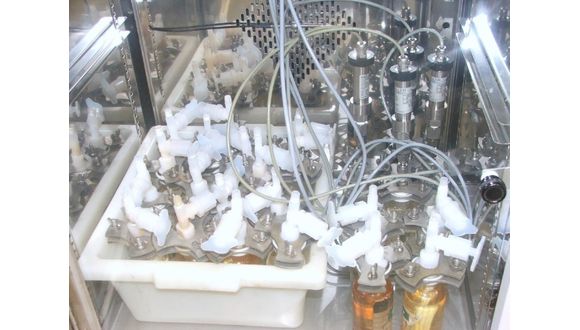Wed, 26 January, 2022
TWI assisted with a recent project funded by the European Space Agency (ESA) to test greener propellants for spacecraft. This novel field of research plays a vital role in improving the environmental sustainability of the space sector.
What is the environmental impact of traditional propellants?
Currently, hydrazine is the most commonly used propellant for satellite thrusters. Other uses include fuelling of launch vehicles, crew modules, scientific space probes and even CubeSats. It is known for its high energy, but considered highly corrosive and toxic, making it dangerous to store and handle.
Seeking to replace hydrazine with more environmentally friendly alternatives, ESA has initiated a new line of research committed to developing and encouraging the adoption of green propellants and propulsion systems, ideally to improve performance while reducing toxicity. Whilst the ultimate goal is to keep the environment and the workforce safe from contamination, there are also financial gains from eliminating the infrastructure needed for handling toxic fuels, which would reduce the cost and cycle time of launching spacecraft.
The activity
As part of this continued effort, ESA sponsored an activity led by European Astrotech in partnership with TWI, Moog and Airbus Defence, and Space UK. Its objective was to investigate the compatibility of promising new green propellants with a variety of materials and weld combinations found in both traditional and new propulsion system architectures. This was vital for understanding if any system modifications would be required to enable future adoption of new propellants.
Fuel compatibility: Where do you even start?
Fuel compatibility is assessed in many ways: from understanding if there are chemical interactions between the propellant and the carrier materials that could degrade the propellant itself (a phenomenon known as leaching); to considering potential oxidation, surface damage or loss of mass by the carrier materials due to corrosion; or even assessing if there are changes to material properties (an example would be hydrogen embrittlement). Furthermore, the analysis should be holistic, considering the various materials and fabrication methods used in pipework, valves, nozzles, storage tanks, etc. Ideally, if the new fuels are compatible with the materials and welds required to fabricate a propulsion system, limited modifications would be needed, which keeps the cost of adoption down and shortens development time.
The approach
An initial review by the consortium outlined a screening programme to test samples from aluminium alloys, titanium alloys and stainless steel, processed by a variety of welding and joining technologies, namely:
- Electron Beam Welding
- Wire Arc Additive Manufacturing
- Friction Stir Welding
- Tungsten Inert Gas
- Rotary Friction Welding
Two green propellants were considered:
- LMP-103S (flight-tested on Sweden’s Prisma formation flying mission)
- HTP (high-test hydrogen peroxide, previously used in past UK rockets)
The tests assessed the degradation of the welds, materials and the propellants over eight months at an elevated temperature. This accelerated test regime allowed replication of the equivalent to 5.33 years in orbit (which is representative of relevant mission durations).
Findings
The trials showed that LMP-103S had good compatibility with all of the weld samples and materials and was also easy to handle and store.
Compatibility testing in HTP has evidenced a need to undertake a more careful material selection for propulsion systems. Titanium was considered to be incompatible with HTP. The Al-Li alloy and stainless steel grades tested suffered some degradation in the initial period of exposure, although results suggest that this could be improved by a controlled pre‑exposure to hydrogen peroxide to promote surface passivation and create a protective oxide layer to delay degradation. Further work on how different surface treatments affect compatibility with HTP is recommended. The AlMgSc alloy tested performed well in the majority of the tests. It displayed good compatibility with both HTP and LMP-103S. This material should be considered for future applications with green propellants.
In terms of compatibility, LMP-103S was considered the most favourable candidate for replacing hydrazine in spacecraft propulsion systems.
 Figure 1. Candidate ‘green’ satellite propellants within a temperature-controlled incubator, undergoing heating as a way to simulate the speeding up of time (Photo: ESA and European Astrotech)
Figure 1. Candidate ‘green’ satellite propellants within a temperature-controlled incubator, undergoing heating as a way to simulate the speeding up of time (Photo: ESA and European Astrotech)
TWI’s role
TWI’s role in the activity was to investigate whether and how the green propellants influenced the structural integrity of the various materials and weld samples. This required undertaking metallography, tensile, fracture toughness and harness testing of samples prior and after various times of immersion in fuel. TWI also developed a FSW procedure for joining Al-Li alloys, which is of particular relevance in the context of fuel tank manufacturing for launch vehicles and satellites.
Propulsion experts, Moog and Airbus Defence and Space, produced the remaining weld and additively manufactured samples. European Astrotech, who are specialists in propellant chemistry and launch site operations, led the compatibility testing and the overall programme.
TWI’s project manager, Joao Gandra explained, “Our team is very excited to have contributed to this activity. Greener propellants play a vital part in improving the environmental sustainability of the Space industry – a sector that will continue to grow in Europe and over the world. This new technology building block will improve the safety of launch operations while reducing their cost ultimately making the industry more accessible.”
The project was supported through ESA’s Technology Development Element, investigating promising innovations for space. It comes in response to the European Commission’s Registration, Evaluation, Authorisation and Restriction of Chemical Substances (REACH) regulation, that seeks to limit industry’s use of chemical substances that may be hazardous to human health or the environment.